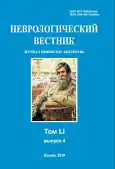Premorbid personal features as a risk factor of bipolar disorder development
- Authors: Osipova N.N.1, Dmitrieva E.V.1, Turanskij M.M.2, Bardenshtejn L.M.2
-
Affiliations:
- Smolensk State Medical University
- Moscow State University of Medicine and Dentistry
- Issue: Vol LI, No 4 (2019)
- Pages: 39-41
- Section: Original study arcticles
- URL: https://journals.rcsi.science/1027-4898/article/view/17910
- DOI: https://doi.org/10.17816/nb17910
- ID: 17910
Cite item
Full Text
Abstract
Aim. Study of the relationship between premorbid personality traits and the tendency to affective bipolar spectrum pathology at the prenosological stage.
Methods. The study involved 129 healthy respondents, the mean age (M=18.27±0.12) years. There were used psychodiagnostic and screening methods: diagnostic scale of bipolar spectrum disorders (Bipolar Spectrum Diagnostic Scale), R. Pies; Mood Disorder Questionnaire (MDQ); Hypomania Checklist (HCL-32); Abbreviated Multifactor Personality Survey (MMPI); Zung Self-Rating Depression Scale.
Results. The results of the MMPI study of students’ personality revealed features that corresponded to the degree of severity of the types of character accentuations, did not reach the degree of pathological values with statistically significant prevalence of values on the scale of “Ma” (hypomania) over all other scales and a decrease in values on the scale of “Pd” (psychopathy). The relationship between bipolar tendencies and personality types was found in respondents of hypomaniacal, hypochondrial, hysteroidal types among girls and paranoia type in boys.
Conclusion. Diagnosis of premorbid personality traits in combination with screening for affective pathology will allow the identification
Full Text
##article.viewOnOriginalSite##About the authors
Natal’ya N. Osipova
Smolensk State Medical University
Author for correspondence.
Email: natinen@yandex.ru
Russian Federation, 214019, Smolensk, Krupskoy Str., 28
Elena V. Dmitrieva
Smolensk State Medical University
Email: natinen@yandex.ru
Russian Federation, 214019, Smolensk, Krupskoy Str., 28
Maksim M. Turanskij
Moscow State University of Medicine and Dentistry
Email: natinen@yandex.ru
Russian Federation, 127473, Moscow, Delegatskaya Str., 20/1
Leonid M. Bardenshtejn
Moscow State University of Medicine and Dentistry
Email: natinen@yandex.ru
Russian Federation, 127473, Moscow, Delegatskaya Str., 20/1
References
- Kraepelin E. Manic-depressive insanity and paranoi. Edinburgh: E & S Livingstone. 1921; 280 p.
- Чумаченко А.А. Проявления психопатологического диатеза у больных эндогенными психическими расстройствами. Автореф. дисс. … канд. мед. наук. СПб. 2003; 23 с. [Chumachenko A.A. Proyavleniya psihopatologicheskogo diateza u bol’nyh ehndogennymi psihicheskimi rasstrojstvami. (Manifestations of psychopathological diathesis in patients with endogenous mental disorders.) Avtoref. diss. … kand. med. nauk. Saint-Petersburg. 2003; 23 p. (In Russ.)]
- Шейнина Н.С., Коцюбинский А.П., Скорик А.И. и др. Психопатологический диатез. СПб.: Гиппократ. 2008; 128 с. [Shejnina N.S., Kocyubinskij A.P., Skorik A.I. et al. Psihopatologicheskij diatez. (Psychopathological diathesis.) Saint-Petersburg: Gippokrat. 2008; 128 p. (In Russ.)]
- Cloninger C.R., Przybeck T.R., Svrakic D.M. The tridimensional personality questionnaire: US normative data. Psychol. Rep. 1991; 69: 1047–1057.
- Klein D.N., Shih J.H. Depressive personality: associations with DSM-III-R mood and personality disorders and negative and positive affectivity, 30-month stability, and prediction of course of axis I depressive disorders. J. Abnormal Psychol. 1998; 107: 319–327.
- Ghaemi S.N., Miller C.J., Berv D.A. et al. Sensitivity and specificity of a new bipolar spectrum diagnostic scale. J. Affect. Dis. 2005; 84 (2–3): 273–277.
- Hirschfeld R.M.A., Williams J.B., Spitzer R.L., Calabrese J.R. Development and validation of a screening instrument for bipolar spectrum disorder: the Mood Disorder Questionnaire. Am. J. Psychiatry. 2000; (157): 1873–1875.
- Angst J., Adolfsson R., Bennazzi F. et al. The HCL-32: Towards a self-assessment tool for hypomanic symptoms in outpatients. J. Affect. Dis. 2005; 88 (22): 217–233.
- Mosolov S.N., Ushkalova A.V., Kostukova E.G. et al. Validation of the Russian version of the Hypomania Checklist (HCL-32) for the detection of Bipolar II disorder in patients with a current diagnosis of recurrent depression. J. Affect. Dis. 2014 (155): 90–95.
- Akiskal H.S., Akiskal K. Cyclothymic, hyperthymic and depressive temperaments as subaffective variants of mood disorders. Ann. Rev. Psychiatr. 1992; 11: 43–62.
- Akiskal H.S. The evolutionary significance of affective temperaments. Medscape. 2003. http://www.psychoeducation.org/depression/akiskal (access date: 05.10.2019).
- Akiskal H.S., Kilzieh N., Maser J.D. et al. The distinct temperament profiles of bipolar I, bipolar II and unipolar patients. J. Affect. Dis. 2006; 92: 19–33.
Supplementary files






